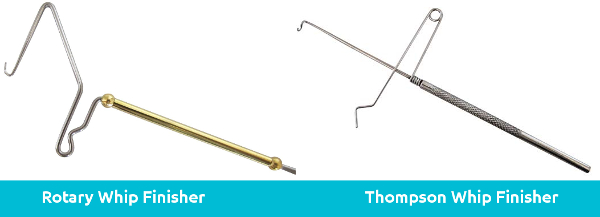What is a whip finish?
A whip finish is the primary knot used by fly tiers to finish off a fly. It is an essential skill to learn for anyone learning how to tie flies. It is necessary to complete (most) every fly with this knot before cutting your tying thread free. Without using this knot at the end of a fly, the fly would fall apart immediately as the thread unravels.
Typically a whip finish knot is tied using a fly tying tool called a whip finisher. There is a freehand method to finish a fly (half hitch knots), but we’ll cover the tools and how to use them to tie a whip finish first.
Tool Selection

Typically you use a fly tying tool called a whip finisher to tie the final knot on a fly. These tools come in the two main varieties shown above. A Rotary whip finisher, and a Thompson whip finisher. Other tool designs do exist, but the above two are the most common.
Neither tool is inherently better at whip finishing than the other, and they both tie the same knot. That being said, it’s much easier to learn how to use a rotary whip finisher. I would recommend anyone trying to learn how to tie a whip finish knot to use a Rotary Whip Finisher (Amazon Link) rather than a Thompson.
How to use a rotary whip finisher?
Okay so not that you have your rotary whip finisher (Also sometimes referred to as a Matarelli style whip finisher), how do you use it? Check out the quick tutorial video below from Tightlinevideo.
Like I said earlier though, there’s nothing wrong with a Thompson. It’s just a bit harder to learn how to use a Thompson whip finisher. Perhaps you’ve already bought one, or had your fly tying tools passed down or gifted to you. I actually couldn’t find a tutorial video showing Thompson that I like enough to share though. If anyone knows of a Thompson video please let me know in the comments below and I’ll be sure to give credit to the creator.
Regardless of which tool you decide to use. The whip finisher is commonly cited as an essential tool for someone learning how to tie flies.
How to whip finish a fly by hand
I’ve seen people ask how to whip finish without a tool. While not identical, a whip finish is very similar to a number of half-hitches combined into one knot. They both serve the same purpose, but they are not identical knots and there is actually a distinction between the two.
A half hitch is a knot with just one rotation around the thread, while a proper whip finish wraps the thread multiple times per knot, which makes it much more secure. Typically if you’re using half hitches, you use multiple in the interest of knot security.
You may know of half hitch from interest other than fly tying. It’s a component of many other knots, and see’s use across a variety of applications. So there’s plenty of youtube videos on how to tie one. The knot doesn’t change just because the application changes, but here’s a how-to video on how to half hitch thread on a hook when fly tying.
As an aside, I absolutely love Tightlinevideos youtube channel. It was one of the primary channels I used when learning to tie flies. He does an excellent job of explaining a wide variety of fly tying techniques.
Half Hitch vs Whip Finisher
Some may ask which is better, a half hitch or a whip finish? Some fly tyers prefer one knot over the other in all instances, but there are certain situations in which a specific method is better than the other.
Personally, I use a whip finisher on the vast majority of the flies I tie. There are some situations in which I use a half hitch knot, or a series of half hitches instead.
Half hitches are useful for situations in which you want some added security but are not yet ready to tie off the fly. They’ll often be used to “save your work” after finishing a specific component of a fly, such as after finishing the body but before starting to tie in the hackle. It’s fairly common practice (not everyone does it though) to do a half hitch after every bundle of deer hair when spinning deer hair for example. When used appropriately, half-hitches can help make flies more sturdy and last longer.
You have a bit more control and can work in a tighter space without the tool in the way. So a half hitch is quite useful if you’ve crowded the hook eye. A crowded hook eye is usually best avoided, but it happens. Some flies such as deer hair bass bugs will naturally have crowded hook eyes. I used half hitches on a few cicada deer hair flies I tied up this morning actually.
Half hitches are also useful when tying extremely small flies. Whip finishers are sometimes not precise enough to finish off size 20+ gnats and midges .
It can also be used if trapping fibers near the hook eye is a concern, such as patterns with antenna (One of my favourite caddisfly patterns, the Goddard Caddis comes to mind).
In summary. I highly recommend a new fly tier get whip finisher as part of the essential beginning tools when they start this hobby.
If you are new to fly tying, I’m sure you’re interested in saving money on supplies. Check out all these cheap and/or free sources of fly tying materials. If you’re just looking to avoid buying an expensive hackle for your dry flies, I list some alternatives for dry fly hackle here.

1 thought on “How to Whip Finish a Fly”